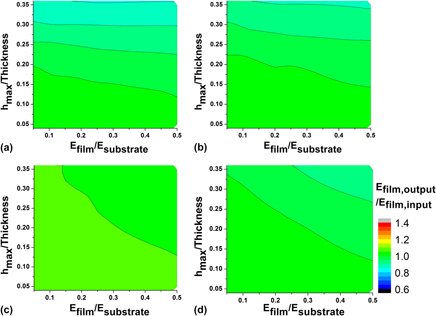Crossref Citations
This article has been cited by the following publications. This list is generated based on data provided by
Crossref.
Fazeli, Sara
Vahedpour, Morteza
and
Sadrnezhaad, Sayed Khatiboleslam
2016.
Comparison of the mechanical properties of NiTi/Cu bilayer by nanoindentation and tensile test: molecular dynamics simulation.
Materials Research Express,
Vol. 3,
Issue. 12,
p.
126504.
Okudur, O. O.
Vanstreels, K.
De Wolf, I.
and
Hangen, U.
2016.
Extraction of elastic modulus of porous ultra-thin low-k films by two-dimensional finite-element simulations of nanoindentation.
Journal of Applied Physics,
Vol. 119,
Issue. 2,
Chang, Alice Chinghsuan
Liao, Juinn-Der
and
Liu, Bernard Haochih
2016.
Practical assessment of nanoscale indentation techniques for the biomechanical properties of biological materials.
Mechanics of Materials,
Vol. 98,
Issue. ,
p.
11.
Wang, Yuemin
Dou, Shuliang
Shang, Lei
Zhang, Panpan
Yan, Xiangqiao
Zhang, Ke
Zhao, Jiupeng
and
Li, Yao
2018.
Effects of Microsphere Size on the Mechanical Properties of Photonic Crystals.
Crystals,
Vol. 8,
Issue. 12,
p.
453.
Zhang, Min
Li, Yang
Kolluru, Pavan V.
and
Brinson, L. Catherine
2018.
Determination of Mechanical Properties of Polymer Interphase Using Combined Atomic Force Microscope (AFM) Experiments and Finite Element Simulations.
Macromolecules,
Vol. 51,
Issue. 20,
p.
8229.
Hirpara, Jignesh
Chawla, Vipin
and
Chandra, Ramesh
2020.
Investigation of tantalum oxynitride for hard and anti-corrosive coating application in diluted hydrochloric acid solutions.
Materials Today Communications,
Vol. 23,
Issue. ,
p.
101113.
Stan, Gheorghe
and
King, Sean W.
2020.
Atomic force microscopy for nanoscale mechanical property characterization.
Journal of Vacuum Science & Technology B, Nanotechnology and Microelectronics: Materials, Processing, Measurement, and Phenomena,
Vol. 38,
Issue. 6,
Malik, Gaurav
Hirpara, Jignesh
Kumar, Ankit
., Nitesh
and
Chandra, Ramesh
2022.
An Electrochemical Based Investigation of Corrosion Inhibit Hydrophobic Ptfe Decorated Tin Coating in Dilute Nacl Solution.
SSRN Electronic Journal ,
Laxmikant Vajire, Sujal
Prashant Singh, Abhishek
Kumar Saini, Dinesh
Kumar Mukhopadhyay, Anoop
Singh, Kulwant
and
Mishra, Dhaneshwar
2022.
Novel machine learning-based prediction approach for nanoindentation load-deformation in a thin film: Applications to electronic industries.
Computers & Industrial Engineering,
Vol. 174,
Issue. ,
p.
108824.
Malik, Gaurav
Tiwari, Pranjala
Choudhary, Nitesh
Hirpara, Jignesh
Kumar, Ankit
and
Chandra, Ramesh
2023.
Investigation of wear and corrosion characteristics of PTFE/TiN composite coating on SS-304 fabricated by two-step sputtering technique.
Surface and Coatings Technology,
Vol. 466,
Issue. ,
p.
129660.
Wang, Zhaoxin
Liu, Dongni
Ji, Wei
and
Li, Ming
2025.
Indentation responses and deformation mechanisms of high-entropy alloy coatings on porous Ti6Al4V substrates: Simulations and dimensional analysis.
Materials Today Communications,
Vol. 44,
Issue. ,
p.
112056.
Wang, Zhaoxin
Guo, Niancheng
Ji, Wei
and
Zhao, Hongwei
2025.
Mechanical characterization of ITO film on glass substrate using a novel indentation method.
Ceramics International,
Vol. 51,
Issue. 1,
p.
1362.



